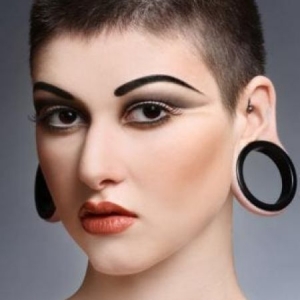The earlobe, for both men and women, is not the only place for jewelry. In some cultures, it reflects social status and is synonymous with prosperity. Archaeological finds of mummies, ancient drawings and paintings indicate that the size of the earlobe was used as a sign of maturity, mainly in men. And medieval physiognomists believed that the longer the lobe, the longer the life.
Indications
The earlobe is more prone to rupture or deformation than other parts of the ear because it consists of skin and fatty tissue, rather than cartilage. Ear piercing can lengthen the original opening, and in some cases a lacerated wound divides the lobe into two segments.
If the puncture is extended by more than eight millimeters, be aware that the hole will never contract by itself to its original size. An aesthetically unattractive lobe is often difficult to hide behind the hair, especially for men with short hair styles.
There are deformations of the lobe caused by the voluntary introduction of «tunnels» - expanders of increasing size. After removal of such a dilator, the lobes, which have completely lost their physiological elasticity, no longer return to their natural size and shape. In this case, only surgery can close the hole and eliminate excess tissue.
There are other reasons for the deformation of the lobe: animal bites, accidents. With age, changes also come that cannot be avoided - loss of shape, decrease in volume. Psychological discomfort can also be an indication for surgery, when no one except you see anything in your ears. In this case, the plastic at the Bogoliuby MC will give you confidence and remove the extra complex.in your ears. In this case, the plastic at the Bogoliuby MC will give you confidence and remove the extra complex. Resizing A congenital anomaly in the lobe may be excessive in size relative to the ear itself, or in asymmetry between the two lobes. Surgical correction in such cases is necessary to create harmony with the rest of the face.
Contraindications
There are a number of contraindications in which you should not resort to plastic. These include:
- bleeding disorders;
- diabetes;
- autoimmune diseases;
- inflammatory processes in the ears
Technique
Despite its apparent simplicity, the plastic of the earlobe is an intervention that requires the experience and professionalism of the operating surgeon, since his goal is to restore his individual form.
This is an outpatient operation that is performed under local anesthesia. The intervention is to remove the skin layer that forms the contour of the crack and to connect the edges with very thin seams. Particular attention is paid to the formation of the lower edge of the lobe.
After plastic surgery, an ointment with antibiotics and means to prevent the formation of hypertrophic scars are applied to the lobe. Contact with water should be avoided for the first 2 to 3 days. The seam is removed after 5 to 7 days. A small scar remains noticeable in the first few weeks, but gradually it disappears and becomes almost invisible.
Four months after the plastic earlobe, it will be possible to make a new hole for the earrings, however, it should be done next to the previous one, and not in the same place. In some cases, a suture thread is inserted into the place where the «first» puncture was located. This thread remains in place for about a month, and then removed, and you will not need to do a puncture again. It is not recommended to wear earrings for at least six months after surgery, under the threat of a new break.
Factors that delay or impair healing are diverse and may have a genetic etiology, in which case they are not controlled by the operating surgeon.
Common factors that interfere with healing include smoking, malnutrition, vitamin deficiency, and excessive sun exposure.

















